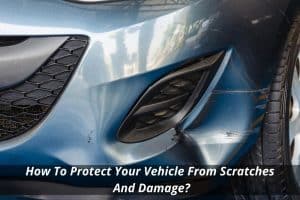How to Protect your Vehicle From Scratches and Damage?
In this article, you’ll need to know how to protect your vehicle from scratches and damage. You probably don’t want to spend too much time cleaning your car or washing your windows because you’d rather focus on other things. But did you know that dirt and dust can cause serious damage to your car? And even worse, they can also scratch and damage your paintwork.
If you’ve ever had a close look at your car, you’ll notice that its surface has lots of tiny imperfections. These are called “dings”, and they come from various sources such as road debris, bird droppings, and even fingerprints.
Dirt and dust can easily get into your car through cracks and crevices. This can result in unsightly marks on your car’s bodywork. Fortunately, there are ways to prevent these problems. In this article, we’ll show you some simple steps to keep your car clean and free from dings.
- Clean Your Car Regularly
The first step is to make sure that your car is cleaned regularly. If it isn’t, the buildup of dirt and dust will only increase over time. The best way to do this is by using an auto detailing kit. It comes with all the tools needed for a thorough cleaning.
- Use A Detailing Kit
A detailing kit is the best way to remove any dirt and grime from your car. It includes everything you need to properly clean your car. There are kits available online, but if you’re looking for something more convenient, then check out our list of the top 5 best-detailing kits.
- Wash Your Windows With Soap
Washing your windows with soap is another effective way to remove dirt and grime from them. All you have to do is use a bucket filled with warm water and dishwashing liquid. Then, spray the solution onto the window and let it sit for about 10 minutes before rinsing off.
- Use An Air Duster
An air duster is one of the most useful tools when it comes to keeping your car clean. It helps you blow away dust and dirt particles from your car’s interior. Just be careful not to touch the nozzle directly on your car’s paintwork. Instead, hold the nozzle about 1-2 inches above the surface.
- Use A Dustpan
Using a dustpan is another great way to keep your car clean. Simply sweep the floor of your car and wipe up any spills immediately. Don’t forget to vacuum under the seats and behind the rearview mirror.
- Keep Your Windshield Washed
Keeping your windshield washed is another important part of maintaining a clean car. You should wash your windshield every week or two depending on how dirty it gets.
- Check For Leaks
Leaking fluids can quickly ruin your car’s interior. To avoid this problem, always check for leaks around door panels, seatbelts, and trunk lids.
- Change Your Oil Every 3 Months
Changing your oil is another essential maintenance task. Make sure that you change your oil every three months. Doing so will help ensure that your car runs smoothly.
- Protect Your Paintwork From Scratches
Protecting your car’s paintwork from scratches is very important. You can do this by applying wax to the areas where you want to protect. Wax also makes your car easier to clean.
- Remove Bird Droppings And Other Debris
Bird droppings and other debris can damage your car’s paintwork, especially if you park outside. To remove them, simply use a soft brush and mild detergent. Be careful not to scratch the paintwork while doing this.
- Keep Your Tires Well Maintained
Tire pressure monitoring systems (TPMS) are helpful because they alert drivers when their tire pressures drop. They also help prevent costly accidents like those caused by flat tires.
- Avoid Driving on Wet Surfaces
Driving on wet surfaces can cause serious damage to your car’s exterior. Always drive on dry pavement whenever possible.
- Drive Safely
Always drive safely. Never speed, tailgate, text, or drink and drive. Stay safe!
- Give Yourself Time
Remember to give yourself plenty of time to complete your daily tasks. You shouldn’t try to rush through your work to save money. Try taking your time instead.
- Have Fun
Finally, make sure to enjoy the process of cleaning and maintaining your car. If you take pride in everything you do, then you’ll find it much more enjoyable than just tackling a pile of chores.
What’s the difference between car wax, polish, and paint protection film?
The main differences between these products are:
Wax vs Polishing
Waxes are designed to protect your car from everyday wear and tear. They’re easy to apply and don’t require additional steps. However, waxes aren’t as durable as polishes. This means that waxes won’t last as long and may need to be reapplied more frequently.
Polishes come in different types including matte, gloss, and semi-gloss. These polishes look shiny and glossy but have a longer-lasting effect. They’re ideal for protecting cars in high-traffic areas such bumpers and headlights.
Film vs Spray
The film isn’t an actual product. It’s a protective layer applied over your car’s surface. The most popular type of film is PTFE (polytetrafluoroethylene). PTFE films are used to protect cars from scratches and dings. They’re available in several shades ranging from clear to black.
Spray paints are usually made up of two components: a base coat and a topcoat.
Both coats must be applied separately. The base coat protects the car’s surface against scratches and dents. Topcoats add colour and shine. They’re often tinted to match the car’s original finish.
A common reason for vehicle scratches and damage?
It’s hard to avoid getting scratched and damaged when driving. Here are some things you should keep in mind to minimize the risk of damage:
- Don’t stop suddenly. When braking, slow down gradually so your wheels don’t skid out of control.
- Slow down at curves and intersections. Braking too quickly will increase the chances of a collision.
- Use cruise control. Cruise control reduces driver fatigue and allows you to focus on other important aspects of driving.
- Use windshield wipers. Wipers ensure visibility during rainstorms and snow storms.
- Park undercover. Parking beneath trees or buildings provides shade and protection from wind and weather.
- Clean off mud and dirt before entering your car. Mud and dirt can scratch your car’s bodywork.
- Use a vacuum cleaner to remove loose debris from the floor mats. Vacuuming helps prevent small objects from falling into the footwells.
- Keep pets away from your car. Pets can cause scratching and damage by running their paws across the car’s surfaces.
- Avoid using sharp items like razors and nail files near your car.
How to Make Your Car Look Better?
Here are some ways for car care tips to help give your car new life:
- Wash your car regularly. Regular washing keeps dust and dirt off the car’s exterior.
- Remove any stickers or decals. Stickers and decals may peel off if they become dirty or wet.
- Scrub the car’s windows. A toothbrush works well for this job.
- Polish your car’s metal panels. Using a microfiber cloth, polish your car’s metal panels to restore their original shine.
- Wax your car. Waxing removes dirt and grime from your car’s surface.
- Buff your car’s interior. Buffing restores leather seats, carpets, and dashboards.
- Replace worn seat covers. Seat covers should be replaced every three years.
- Install aftermarket accessories. Aftermarket accessories include everything from spoilers to custom paint jobs.
- Reupholster your seats. Upholstery kits make it easy to replace old seats with new ones.
- Add a sunroof. Sunroofs provide additional ventilation and light inside your car.
- Paint your car a bright colour. Bright colours are easier to spot when parked next to dark vehicles.
- Change your car’s tire pressure. Changing tire pressure increases fuel efficiency.
- Check your car’s fluid level. Checking the air pressure in your tires and radiator is an inexpensive way to improve performance.
- Have your brakes checked? If your brake pads have worn thin, replacing them could save money and time.
- Change your engine oil. Oil level changes reduce wear on internal moving parts and extend the life of your engine.
- Inspect your battery. Batteries lose power over time. Replacing a dead battery is less expensive than charging a dead battery.
- Get your car serviced. Have your car’s spark plugs changed, belts tightened, and your hoses inspected.
- Change your wiper blades. Wiper blades need to be replaced periodically.
- Fix squeaks and rattles. This can be done by tightening bolts and adjusting trim pieces.
- Check your lights. Lights that work properly will increase safety while driving at night.
- Change your filters. Filters trap dirt and debris to keep your engine clean.
- Change your headlights. Headlight bulbs burn out quickly, so changing them annually saves money.
- Check your trunk release. The trunk release must be located where it can be easily reached without putting your hands in the car.
- Clean your windshield wipers. Dirty windshield wipers can clog up your windshield.
- Service your steering wheel. Steering wheels often develop cracks and other problems that require replacement.
- Get a tune-up. Tune-ups check all systems in your car for proper operation. They also ensure that you’re not wasting gas.



